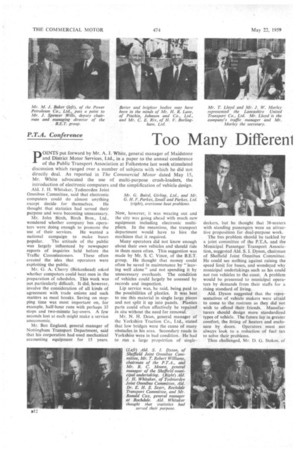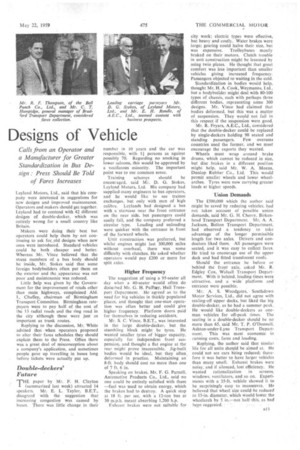Too Many Differenl Designs of Vehicle
Page 46

Page 47

If you've noticed an error in this article please click here to report it so we can fix it.
pOINTS put forward by Mr. A. J. White, general manager of Maidstone and District Motor Services, Ltd.; in a paper to the annual conference of the Public Transport Association at Folkestone last week stimulated discussion which ranged over a number of subjects with which he did not directly deal. As reported in The Commercial Motor dated May 15,
Mr. White advocated the use of multi-purpose crush-loaders, the
introduction of electronic computers and the simplification of vehicle design.
Aid. J. H. Whitaker, Todmorden Joint Omnibus Committee, said that electronic computers could do almost anything except decide for themselves. He thought that statistics had served their purpose and were becoming unnecessary.
Mr. John Birch, Birch _ Bros., Ltd., wondered whether company bus operators were doing enough to Promote the use of their services. He wanted a national campaign to make buses popular. The attitude of the public was largely influenced by newspaper reports of inquiries held before the Traffic Commissioners. These often created the idea that operators were exploiting the public.
Mr. G. A. Cherry (Birkenhead) asked whether computers could beat men in the preparation of schedules. This work was not particularly difficult. It did, however, involve the consideration of all kinds of agreement with trade unions and such matttrs as meal breaks. Saving on stopping time was most important on, for example, half-hour runs with perhaps 35 stops and two-minute lay-overs. A few seconds lost at each might make a service uneconomic.
Mr. Ben England, general manager of Nottingham Transport Department, said that his corporation had used mechanical accounting equipment for 15 years. Now, however, it was wearing out and the city was going ahead with much new equipment including electronic multipliers. In the meantime, the transport department would have to hire the machines that it required.
Many operators did not know enough about their own vehicles and should tide in them more often. This suggestion was made by Mr. S. C. Vince, of the B.E.T. group. He thought that money could often be saved in maintenance by "leaving well alone" and not spending it by unnecessary overhauls. The condition of vehicles could largely be assessed by records and inspection.
Lip service was, he said, being paid to the possibilities of plastics. It was best to use this material in single large pieces and not split it up into panels. Plastics parts could often effectively be repaired in situ without the need for removal.
Mr. N. H. Dean, general manager of the Yorkshire Traction Co., Ltd., stated that low bridges were the cause of many obstacles in his area. Secondary roads in Yorkshire were in bad condition. He had to run a large propcirtion of single deckers, but he thought that 38-seaters with standing passengers were an attractive proposition for dual-purpose work.
The bus problem should be tackled by a joint committee of the P.T.A. and the Municipal Passenger Transport Association, suggested Aid. S. I. Dyson, chairman of Sheffield Joint Omnibus Committee. He could see nothing against raising the speed limit for buses, and wondered why municipal undertakings such as his could not run vehicles to the coast. A problem would be presented to municipal operators by demands from their staffs for a rising standard of living.
Aid. Dyson suggested that the representatives of vehicle makers were afraid to come to the rostrum as they did not wish to offend their friends. Manufacturers should design more standardized types of vehicle. The future lay in greater comfort, the fitting of heaters and enclosure by doors. Operators must not always look to a reduction of fuel tax to solve their problems.
Thus challenged, Mr. D. G. Stokes, of
Leyland Motors, Ltd., said that his company were interested in suggestions for new designs and improved maintenance. Operators and makers should get together. Leyland had to contend with 42 different designs of double-decker, which was entirely wrong for a small country like Britain.
Makers were doing their best but operators could help them by not continuing to ask foreold designs when new ones were introduced. Standard vehicles could be both cheaper and better. Whereas Mr. Vince believed that the stress members of a bus body should he inside, Mr. Stokes said that some foreign bodybuilders often put them on the exterior and the _appearance was not poor and maintenance was reduced.
Little help was given by the Government for the improvement of roads other than main highways, complained Ald. L. Chalky, chairman of Birmingham Transport Committee. Birmingham ratepayers were to pay half of the cost of the 13 radial roads and the ring road in the city although these were just as important as trunk routes. .
Replying to the discussion, Mr. White advised that .when operators proposed to alter their fares schedules they should explain them to the Press. Often there was a great deal of misconception about a company's application, and sometimes people gave up travelling in buses long before tickets were actually put up.
Double-deckers' Future
THE paper by Mr. F. H. Clayton
(summarized last week) attracted 14 speakers. Mr. E. L. Taylor, B.E.T., disagreed with the suggestion that increasing congestion was caused by buses. There was little change in their number in 10 years and the car was responsible, with If persons as against possibly 70. Regarding no smoking in lower saloons, this would be approved by a vociferous minority. The important point was to use common sense.
Training schemes should be encouraged, said Mr. D. G. Stokes, Leyland Motors, Ltd. His company had supplied many engineers to bus operators, and he would like to see trainee exchanges, but only with men of high calibre. Leylands had designed a bus with a -staircase near the front entrance on the near side, but passengers could easily fall, and the company preferred a circular type. Loading and unloading were quicker with the entrance in front of the forward wheels.
Unit construction, was preferred, but whilst engines might last 300,000 miles without overhaul, there was some difficulty with clutches. He asked whether operators would pay £200 or more for split axles.
Higher Frequency
The suggestion of using a 95-seater all day when a 40-seater would often do disturbed Mr. G. H. Pulfrey, Hull Transport Department. He agreed as to the need for big vehicles in thickly populated places, and thought that one-man operation was often better and could •give higher frequency. Platform doors paid for themselves in reducing accidents.
Mr. S. C. Vince, B.E.T., was interested in the large double-decker, but the stumbling block might be tyres. He wanted smaller tyres of bigger capacity, especially for independent front suspension, and thought a flat engine at the rear might prove inaccessible. Jig-built bodies would be ideal, but they often deformed in practice. Maintaining an 8-ft. body should cost no more than one of 7 ft. 6 in.
Speaking on brakes, Mr. F. G. Parnell, Automotive Products Co., Ltd., said no one could be entirely satisfied with them —fuel was used to obtain energy, which the brakes had to destroy. A quick stop at 18 ft. per sec. with a 12-ton bus at 30 m.p.h. meant absorbing 1,200 h.p.
Exhaust brakes were not suitable for city work; electric types were effective, but heavy and costly. Water brakes were large; gearing could halve their size, but was expensive. Trolleybuses mostly braked on their motors. Clutch trouble in unit construction might be lessened by using twin plates. He thought that great comfort was less important than smaller vehicles giving increased frequency. Passengers objected to waiting in the cold.
Standardization in bodies would help, thought Mr. H. A. Cook, Weymanns, Ltd., but a bodybuilder might deal with 80-100 types of chassis, each with perhaps three different bodies, representing some 300 designs. Mr. Vince had claimed that bodies deformed, but this was a matter of suspension. They would not fail in this respect if the suspension were good.
Mr. R. Fryars, A.E.C., Ltd., considered that the double-decker could be replaced by single-deckers holding 90 seated and standing passengers. Few overseas countries used the former, and we must encourage the exports they wanted.
Wheels must wrap around brake drums, which cannot be reduced in size, but disc brakes in a different position might help, said Mr. W. A. Moens, Dunlop Rubber Co., Ltd. This would permit smaller wheels and lower wheelarches. Tyres were now carrying greater loads at higher speeds.
Union Demands
The £500,000 which the author said might be saved by reducing vehicles, had not taken account of possible union demands, said Mr. G. H. Cherry, Birkenhead Transport Department. Mr. A. A. Jackson, Bolton Transport Department, had observed a tendency to take advantage of the longer permissible length for two axles. Drivers and conductors liked them. All passengers were seated, and it was easy to collect fares. He tried to encourage use of the upper deck and had fitted translucent roofs.
Should the entrance be before or behind the front axle. asked Mr. R. Edgley Cox, Walsall Transport Department. With it behind, loading times were attractive, and a wide platform and entrance were possible.
• Mr. A. S. Woodgates, Southdown Motor Services, Ltd.. did not agree with sealing-off upper decks, but liked the big double-decker, as he had a summer peak. He would like double-deckers as oneman vehicles for off-peak times. The seating in a double-decker should be no more than 65, said Mr. T. P. O'Donnell, Ashton-under-Lyne Transport Department. This was most economic in running costs, fares and loading.
Replying, the author said that similar life for all units should be aimed at. He could not see cars heing reduced; therefore it was better to have larger vehicles than many small. Exhaust brakes were noisy, and if silenced, lost efficiency. He wanted rationalization in screens, windows, ventilators,and so on. Experiments with a 35-ft. vehicle showed it to be surprisingly easy to manceuvre. He believed that wheel size coiild,be reduced to 15-in. diameter, which uVould loser. the wheelarch• by 5 in.-not half-thiS, as had been suggested.


































































































